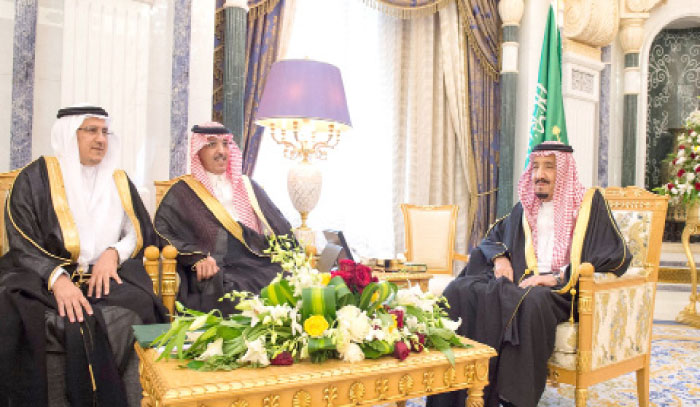
Robust economy
Custodian of the Two Holy Mosques King Salman received on Monday the 52nd annual report of Saudi Arabian Monetary Agency (SAMA), which reviews the most prominent domestic and global economic developments for the fiscal year 2015.
The report was presented to the King by Minister of Finance Mohammed Al-Jada’an and SAMA Governor Dr. Ahmed Al-Khulaifi.
The report included the monetary and banking developments, balance of payments and the latest developments in public finances, oil and non-oil sectors, activities of insurance and finance market.
According to the report, Gross Domestic Product (GDP) at constant prices would grow by 1.8 percent in 2016.
At the sectors level, projections show that the oil sector real GDP would increase by 1.2 percent, whereas the non-oil sector GDP would increase by 2.5 percent in 2016.
It is also expected that the non-oil government sector would record a growth rate of 1.8 percent, and the non-oil private sector would grow by 2.8 percent.
The current account is projected to record a deficit of 9.4 percent of GDP, and the inflation rate is expected to range between 3.8 percent and 4.3 percent (base year 2007) in 2016.
Preliminary figures of the actual revenues and expenditures for fiscal year 2015 indicate that actual revenues fell by 41.0 percent to SR615.9 billion compared to SR1,044.4 billion in the preceding year. Actual expenditures went down by 11.9 percent to SR978.1 billion.
Current expenditure accounted for 73.0 percent of total expenditures, while capital expenditure accounted for the remaining percentage. Actual deficit was SR362.2 billion compared to a deficit of SR65.5 billion in 2014. Oil revenues constituted 72.5 percent of the bulk of total revenues in 2015.
The actual state budget registered a deficit of S362.2 billion in 2015. The current account of balance of payments recorded a deficit of SR200.5 billion or 8.2 percent of GDP in 2015. Broad money (M3) increased by 2.6 percent to SR1,774.1 billion.
Foreign investment
With regards to foreign investment, the Saudi Arabian General Investment Authority (SAGIA) issued 41 licenses to industrial establishments with a capital of SR1.0 billion in 2015.
Therefore, the number of foreign establishments up to the end of 2015 reached 8,908 (industrial, service and other) with a capital of approximately SR673.1 billion.
The number of Saudi employees working therein reached 153,600, representing 22 percent of total employees and with monthly wages averaging SR6,833.
Labor market
The latest data of the General Authority for Statistics indicate that unemployment rate declined from 5.7 percent of total labor force in 2014 to 5.6 percent in 2015. Unemployed Saudis accounted for 11.5 percent of total Saudi labor force compared to 11.7 percent in the previous year.
Unemployed Saudi male workers accounted for 5.3 percent of total Saudi male labor force, unemployed Saudi female workers 33.8 percent of total Saudi female labor force, and unemployed non-Saudis 0.5 percent of total non-Saudi labor force in the Kingdom.
The latest figures issued by the Ministry of Labor and Social Development showed that the number of workers in the private sector (Saudis and non-Saudis) was 10.6 million at the end of 2015, increasing by 5.5 percent over the preceding year. The ratio of Saudis working in the private sector to total workers in the sector was 16.4 percent.
Banking system
The Saudi banking system continued to be robust and strong despite the decreases in the consolidated balance sheet for the Saudi banking system. The monetary indicated a decrease in the assets of the banking system as a whole by 5.3 percent (SR224.7 billion) to SR4.0 trillion in 2015 compared with an increase of 4.7 percent (SR189 billion) in 2014.
Cost of Living Index
All major cities of the Kingdom (except Tabuk) registered an increase in the cost of living index. Jazan recorded the highest increase rate of 5.4 percent. Arar came second with 5.3 percent. Riyadh placed third with 3.8 percent, followed by Sakaka with 3.4 percent; Al-Baha and Buraidah 3.0 percent each; Najran 2.7 percent; Makkah 2.2 percent; Jeddah 1.8 percent; Abha 1.5 percent; Madinah 1.4 percent; and Al-Dammam 1.0 percent. Tabuk, however, registered a decline of 6.7 percent.
Data on GDP at constant prices indicates that it grew by 3.5 percent to SR2,520.8 billion in 2015 compared to a growth of 3.6 percent in 2014. The oil sector GDP increased by 4.0 percent to SR1,085.1 billion, while the non-oil sector GDP rose by 3.1 percent to SR1,414.9 billion.
The growth rate of the non-oil private sector GDP went up by 3.4 percent to SR 989.9 billion, and that of the non-oil government sector by 2.5 percent to SR 424.9 billion.
Major economic activities
Manufacturing industries activity grew by 5.8 percent, the construction and building activity by 5.6 percent, electricity, gas and water activity by 5.3 percent, transport, storage and communications activity by 4.0 percent, mining and quarrying activity by 3.2 percent, wholesale and retail trade, restaurants and hotels activity by 3.0 percent, finance, insurance, real estate and business services activity by 2.9 percent; community, social, and personal services activity by 2.7 percent; the activity of the government services’ producers by 2.3 percent; and agriculture, forestry and fishing activity by 1.1 percent over the previous year.
Addressing a press conference, SAMA governor said that Saudi Arabia has a “very comfortable” level of foreign reserves.
“I think we are very comfortable. We have no issue with that,” he said.


























